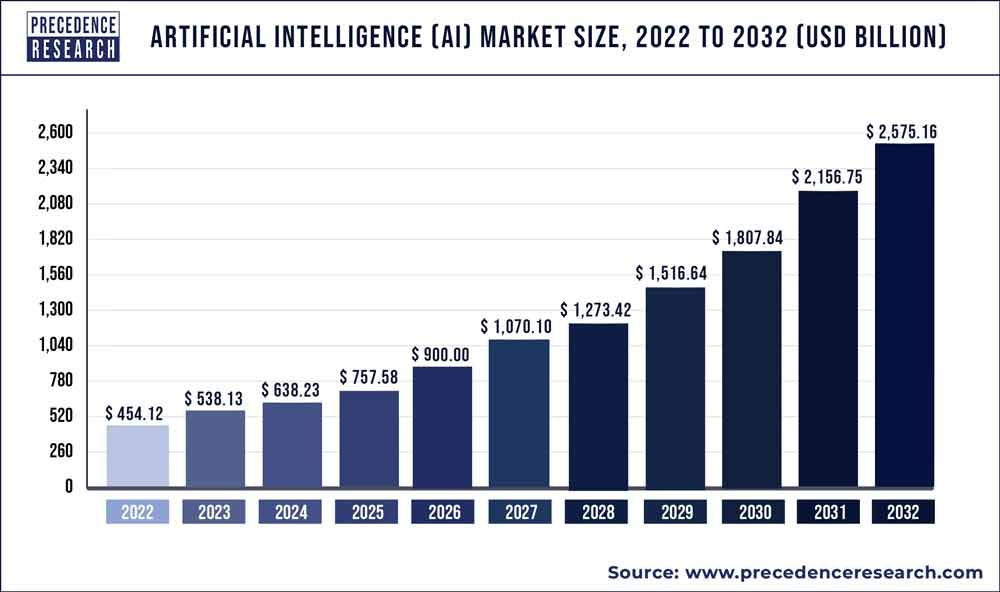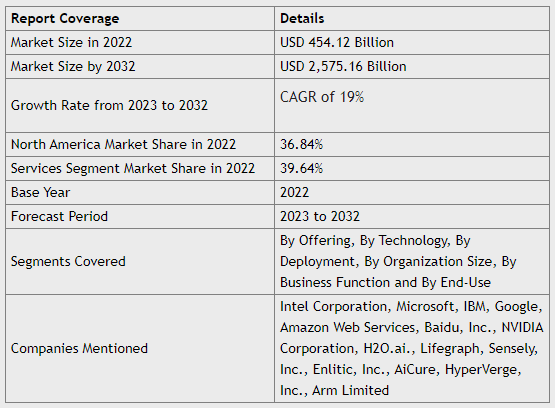The rapid proliferation of AI tools and solutions in recent months has ignited discussions among industry experts and investors alike. Are we witnessing the zenith of AI’s golden age, or are we on the precipice of a market saturated beyond capacity?
The tech landscape has always been dynamic, with innovations often outpacing the market’s ability to adapt.
The allure of artificial intelligence
The global artificial intelligence (AI) market size was valued at USD 454.12 billion in 2022 and is expected to hit around USD 2,575.16 billion by 2032, progressing with a compound annual growth rate (CAGR) of 19% from 2023 to 2032. The North America artificial intelligence market was valued at USD 167.30 billion in 2022.

Growth Factors
The rapid penetration of digital technologies and the internet has significantly contributed to the growth of the global artificial intelligence market in the past few years. The heavy investments by the tech giants in research and development are continuously fueling technological advancements in various industries. The burgeoning demand for artificial technology among the various end-use verticals such as automotive, healthcare, banking & finance, manufacturing, food and beverages, logistics, and retail is expected to significantly drive the growth of the global artificial intelligence market in the forthcoming years. Technological innovations have been always an important part of the majority of industries.
The rising popularity of various life-saving medical devices and the self-driving feature in the new electric vehicles is significantly boosting the growth of the AI market across the globe. The shifting focus of the globe towards the digitalization is positively impacting the market growth. The top global tech giants such as Google, Microsoft, IBM, Amazon, and Apple are increasing their investments in the upgradation and development of various applications of AI. The rising efforts of the tech giants towards improving the access to the AI is expected to foster the growth of the global AI market during the forecast period.
Favorable government initiatives are expected to impose a positive impact on industry growth. The establishment of subcommittees on machine learning and AI within the federal government has drawn the traction towards the AI industry. In 2020, The Government of India increased the spend for Digital India to $477 million to boost AI, IoT, big data, cyber security, machine learning and robotics. The artificial intelligence market is expected to witness significant growth in the BFSI sector on account of data mining applications as there is an increase in the adoption of artificial intelligence solutions in data analytics, fraud detection, cybersecurity, and database systems.
End-use industries have started integrating artificial intelligence into their business processes to streamline their operations. The artificial intelligence technology is gaining momentum as it assists enduser organizations to become more efficient and result oriented. The growing adoption of artificial intelligence is encouraging new entrants to venture into the AI marketplace by offering niche applicationspecific products and solutions. Furthermore, companies are also taking several strategic initiatives in industry consolidations to gain competitive advantages.
AI’s impact goes beyond speculation
While the dot-com and blockchain bubbles were characterized by speculation and, at times, a lack of authentic value, the AI wave is fundamentally different.
Companies like Microsoft and Google are not just dabbling in AI — they’re integrating it into products and services that millions use daily, showcasing real-world applications that are actively improving industries.
Michael Koch, co-founder and CEO of HubKonnect, an AI platform for local store marketing campaigns said:
“The AI market feels saturated because people who thought they were technologists and failed at crypto are now moving onto the next hot technology, which is AI — but there are actually real builders and leaders in AI. There needs to be advanced eyes out there for people to really continue to build and take advantage of the evolution of AI.”
The modern AI gold rush
The allure of artificial intelligence has led to a surge in AI-driven tools, solutions and startups. According to Precedence Research, the global artificial intelligence market was valued at $454 billion in 2022 and is projected to grow to $538 billion in 2023.
Venture capital (VC) has been a significant funding source for the AI sector in 2023. Data from PitchBook indicates that generative AI startups raised over $1.7 billion in Q1 of 2023, with an additional $10.7 billion worth of deals announced that were not yet completed.
Some of the most notable raises included Google-backed Anthropic, which secured $450 million at a reported $5 billion valuation. Builder.AI raised $250 million. Mistral AI managed to raise $113 million without a product or even a proof-of-concept. With the injection of VC thrown at these AI startups like wildfire, one can draw some similarities to the ICO bust. In that situation, there was also a lot of hype without any actual use cases or proof of viability. However, what distinguishes AI is its multitude of use cases and real-life examples of success. Take, for instance, ChatGPT, which rapidly reached 100 million users in just two months, demonstrating AI’s tangible impact.
However, with rapid growth and high valuations, some feel the AI market is overheating. JPMorgan market strategist Marko Kolanovic believes the AI market is nearing saturation point. As reported by Forbes, Kolanovic said the market’s recent growth is the result of an “AI-driven bubble” and that the hype surrounding the technology is due to “the popularity of chatbots that often fail.” in basic questions” rather than “powered by AI”.
Leif-Nissen Lundbæk, founder and CEO of Generative AI company Xayn, has a contrary view and believes that we are only at the tip of the iceberg. He say:
“The AI market is not close to becoming saturated. Currently, companies have tried their hand here and there, with some proofs-of-concept materializing. The real large-scale production cases are only getting started, or are yet to come.”
Saturation and innovation
The sheer volume of companies entering the AI space has raised concerns about a potentially saturated market. Companies worldwide are now utilizing AI as part of their core functionalities. From 10Web’s no-code website builder to RainbowAI’s weather app, and from ICarbonX’s AI providing personalized health analyses to SherpaAI’s virtual personal assistant, the stage has been set for countless others to follow suit.
Lundbæk recognizes that the influx of new companies could lead to the market becoming saturated in some areas but does not see it as a pertinent issue, stating, “The business-to-customer market is perhaps a bit more saturated but has not yet reached full capacity, while the business-to-business market is only in its infancy, even though AI has been around for a while. The vast majority of corporations are only using AI or machine learning for a few visible projects, if at all, that are easier to implement with lower risk, but aren’t applying it yet on a large scale.”
Koch says that the influx of newcomers might give the illusion of an oversaturated AI market, but he views initial saturation as a necessary phase to foster future advancements.
He stated: “AI will never be saturated because we are only on the first off-ramp of the AI super highway. It seems saturated because people from other industries are trying to step into the space, but when it comes down to innovation, there’s already a select group of companies that are so far ahead and that have been in the AI space for decades. To be able to drive innovation forward, saturation will arise at a basic level, but there are elite players and companies that are leading the future of AI.”
Market Dynamics
Driver: Rising implementation from the finance sector
The global finance sector is witnessing a major shift with the rapid acceptance of artificial intelligence technology. The rising implementation of artificial intelligence in the finance sector is transforming industry in several ways. Artificial intelligence is being used for algorithmic trading, fraud detection and credit risk assessment. It enables quicker and more accurate data analysis, leading to better investment decisions along with risk management. AI carries the ability to process large amounts of data and also aids in identifying patterns and trends that human agents might miss. Overall, artificial intelligence is enhancing operational efficiency, reducing costs and improving customer experience in the finance sector.
Restraint: Transparency in decision making
Artificial intelligence models and algorithms are generally complex. The complex nature of models makes it difficult to understand the process of decision making. Artificial intelligence-based solutions often generate outcomes that come up with black box nature, this can lead to lack of trust and accountability. This is particularly concerning in critical areas such as finance and healthcare. These industries or end users have a delicate need for transparency in order to protect the proprietary. Thus, transparency issues in decision making hamper the growth of the market.
Opportunity: Rising acceptance from research scientists
Research scientists are increasingly embracing artificial intelligence technology due to its transformative capabilities. This trend is expected to be continued in the upcoming years while offering an opportunity for the artificial intelligence market to expand. Technology accelerates data analysis, identifies patterns and aids in complex stimulations, enabling breakthroughs across diverse sectors. Ai-powered tools streamline repetitive tasks, liberating scientists to focus on innovation. In many fields, research scientists have started appreciating the importance and potential of AI to predict outcomes, discover hidden insights and optimize experiments. Overall, the scientific community recognizes AIs role in amplifying research efficiency and driving new discoveries, leading to a more symbiotic relationship between technology and human expertise.
Challenge: Lack of skilled professionals
The system with artificial intelligence technology needs skilled professionals, whereas the shortage or lack of such skilled and qualified professionals creates a major challenge for the market. Artificial intelligence technologies require specialized expertise in areas like machine learning, data science and software engineering. The demand for these professionals exceeds the supply, leading to talent shortages that can slow down AI development, implementation and innovation. Moreover, this shortage can limit the scalability and effectiveness of AI solutions across various industries. Thus, the lack of skilled professionals is observed to act as a challenge for the market’s expansion.
Report Scope of the Artificial Intelligence Market
Below are some reports forecasting revenue growth in the field of artificial intelligence until 2030:

Global Artificial Intelligence (AI) Market Revenue, By Technology, 2022-2032(US$ Billion)

Global Artificial Intelligence (AI) Market Revenue, By Solution, 2022-2032 (US$ Billion)

Global Artificial Intelligence (AI) Market Revenue, By End User, 2022-2032 (US$ Billion)

Global Artificial Intelligence (AI) Market Revenue, By Region, 2022-2032 (US$ Billion)

Reflection on AI market dynamics
Rapid growth, high valuations and a wave of new entrants into the AI sector have sparked debates about market saturation. Historical technology bubbles, such as the dot-com era and the blockchain hype, serve as reminders of the potential consequences of unchecked growth and speculation.
However, the potential depth of AI has not yet been fully realized. The tangible impact of technology speaks to its real and transformative nature.
It is clear that the AI market is very diverse. As with any evolving technology, the challenge is to strike a balance between rapid growth and sustainable development.






